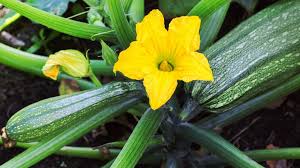By Barbara Pleasant7 July 2016
Squash are a popular garden crop, but gardeners often face challenges when growing them. Recently, I’ve received several questions about squash plants that are blooming but not producing fruit. Let’s explore three common squash problems and their solutions:
1. Squash Flowering but Not Fruiting
Debby, a seasoned gardener, encountered a common issue in her container-grown zucchini plants. While the plants bloomed abundantly, they weren’t setting fruit. To solve this, I asked her to inspect the flowers closely to differentiate between male and female blossoms. Male flowers grow on a straight green stem, while female flowers are attached to a tiny squash.
Debby’s plants were producing mostly male flowers early on, a typical trait in many squash varieties. Male flowers attract pollinators, but if the weather is cool or rainy, or if there aren’t enough insects, pollination can be insufficient. I suggested that Debby watch for bees in the morning and use a small artist’s paintbrush to transfer pollen from the male flowers to the female flowers if needed. This hand-pollination method can help ensure fruit production when natural pollinators are scarce.

2. Poor Squash Pollination
Marietta experienced a different problem with her yellow crookneck squash. Her plants were setting small fruits that were shriveling and rotting rather than growing into full-sized squash. After confirming that there were male flowers present for pollination, we ruled out a lack of pollinators.
The issue likely stemmed from the failure of the female flowers’ corolla (the petal-like part of the flower) to properly support pollination. This can happen in warm or damp conditions, causing the pollen grains to die prematurely or the pollen tubes to grow too slowly. When this happens, the flower and the developing fruit often decay, aided by moisture-loving bacteria and fungi.
Marietta was on the right track by removing the shriveled squash and composting them. To address potential micronutrient deficiencies, she added compost to her sandy soil, which should help her plants recover. With improved weather, we hoped the situation would improve.

3. Controlling Cucumber Beetles Organically
Mark had a different problem: his squash plants were being overrun by cucumber beetles. These yellow-and-black striped pests feed on cucurbit crops and can transmit diseases, weakening the plants. To tackle this, I recommended that Mark create a “sticky wand” by coating a piece of cardboard or plastic with glue. By touching the beetles with the sticky surface, he could collect them without damaging the plants, as the wand wouldn’t stick to the squash’s hairy leaves.
After a few days, Mark reported that the beetles seemed to have vanished. This was due to the presence of predators in his garden. Cucumber beetles are extremely vulnerable to natural predators like wolf spiders and ground beetles. These beneficial insects help control the pest population. Mark also used row covers to protect the most affected plants from further damage, and his garden’s diverse ecosystem helped keep the beetle population in check.

These common squash problems can often be managed with a little observation and action. By ensuring proper pollination, addressing environmental factors, and encouraging natural predators, gardeners can enjoy a healthy squash harvest.
